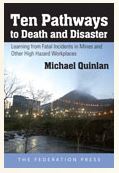Victorian Premier Daniel Andrews has spoken publicly about the removal of the CEO and Chair of WorkSafe Victoria describing them as liars and incompetent. As Jon Faine pointed out in the radio interview, the Premier has established a high level of accountability. Hopefully this results in an increased diligence on OHS matters by government departments and authorities.
The Industrial Relations Minister in the Andrews Government, Robin Scott, was a



 SafetyAtWorkBlog has
SafetyAtWorkBlog has